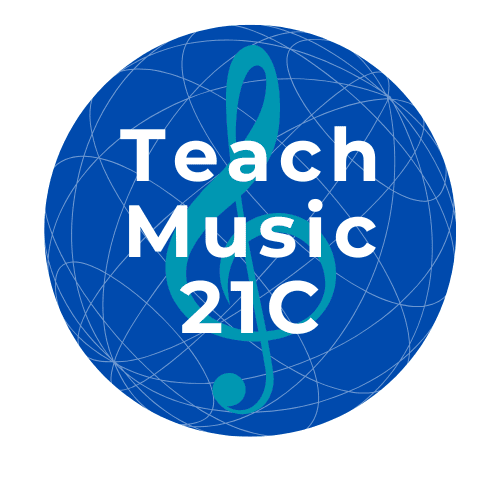Please enjoy this guest post from Paul McGlinchey, executive team member in charge of Community Development at Teach Music 21C. Thanks Paul for sharing your thoughts.
Music teachers are already designers, whether we realize it or not. We're especially good at designing a given student's curriculum, and we've probably got lots of experience designing weekly lesson plans. Perhaps we take great care with how our teaching studio looks and feels. Is it inviting and comfortable, is it conducive to interest, engagement, and learning?
If we give a gift to someone we care deeply about, do we hand it over to them without concern for how it will be appreciated and enjoyed?
We can imagine every assignment we give our students as a gift that shapes how our they approach their practice time between lessons. Each practice session can become an invitation to explore how they relate to music itself.
The question isn't whether we're designing music practice—it's whether we're doing it intentionally.

A Design Thinking Approach to Music Practice
Design thinking is a human-centered approach to creating meaningful experiences. It offers a powerful framework for reimagining music practice.
Just as product designers create experiences people want to return to, we can craft practice experiences that students eagerly engage with.
To that end, here's a quick overview of how we can begin to apply the principles of design thinking to music practice:
- Focus on an individual student
- You and your student create an initial version—a prototype; an experiment—of an experience that both of you imagine they will want to return to again and again
- Your student tests how well it works in their lesson and during the week between lessons
- Get feedback from your student
- Based on the feedback and some reflection with your student, make adjustments to the original version
- Repeat the loop of test, feedback, and revision until you have a design that the student wants to return to again and again
Yes, the requirement that practice is an invitation that your student wants to return to again and again is a high bar to reach. This is the challenge of reimagining music practice: not staying with the same middle bar we've always held on to.
As we move through a more detailed description of designing music practice, at each step I'll invoke a mythical music student named Maya. As you'll soon discover, her story is ideal for demonstrating and clarifying how you might be able to use this process in your studio.

1. Focus on an Individual Student
When we think about practice design, we begin with one student, not a generalized approach. Each student has their unique relationship with music. They have their own way of seeing, hearing, and responding to "the infinite variety of music" (Leonard Bernstein). They also have their temperament, learning strengths and challenges, and life outside our studio. Just as we might carefully select a gift that is meant for a specific someone we care about, we should approach practice design with this same attention to the particular person before us.
To begin the design process, here are some relevant and potentially revealing observations to consider:
- What musical qualities resonate most deeply with this student?
- Where do they consistently struggle?
- What aspects of their life beyond music might illuminate their relationship with practice?
These aren't casual questions but essential materials for creating a practice experience that speaks to who they truly are.
Maya, a 12-year-old piano student, was struggling with consistent practice. Her teacher noticed how Maya's face lit up when she talked about group projects at school. Through thoughtful conversation, the teacher discovered Maya was deeply motivated by social connection. This understanding of Maya as an individual with her own particular way of responding to the world became the foundation for reimagining her practice routine.
Questions for deeper reflection:
- What qualities of temperament, interest, and need might help you understand each student's unique relationship with practice?
- What do you know already about what truly connects them to music?
2. Create a Prototype Practice Experience Together
Let's say you have taken the first step. Your familiarity with all of your students has helped you identify a particular student who could benefit from a new approach to practicing. And you believe they would be interested in such a project. You've come to understand your student from the specific perspective of crafting a music practice design just for them. All of this has inspired you to begin collaborating with that individual student to make an initial version of a delightful practice experience—a design prototype.
Don't imagine this step as simply about imposing greater efficiency or systematic structure. Rather, allow it to be about creating conditions where the student can encounter practice as a safe, engaging activity that invites their response.
Resist the need to "get it right" the first time. Frame this step explicitly as an experiment you and your student are creating together. Remove inhibiting pressures. Make space for discovery. Ideally, the prototype should have enough structure to provide guidance but enough openness to allow the student to contribute ideas and make choices throughout the entire process.
Recognizing Maya's need for social connection, her teacher proposed creating a "practice partnership." Together, they sketched out a framework: three 10-minute practice sessions per week, each concluding with a brief video sharing something discovered or improved. Maya suggested they could exchange themed challenges, further personalizing their shared experiment.
Questions to help with co-creating and prototyping:
- How might you invite your students into designing their own practice experiences rather than simply assigning tasks?
- What would change if practice became a space where students could recognize their own needs, and influence their own musical journey?

3. Test the Prototype During Lessons and Practice Sessions
The purpose of this next step is to determine how the initial practice design might develop. It's not just instructional, it's invitational. The objective is to reveal how well this particular design creates opportunities for genuine musical engagement.
The big question is: are the initial ideas about what will engage the student accurate? It's the moment when theory meets reality, and when you see how the student actually responds to the practice design you've created together.
First, test-drive the new design process with your student in their lesson. They will need to be able to operate the design on their own during the week, so making sure they can do so before the week starts is a must. Ensure you both agree on how it's "supposed to work".
During the week between lessons, have the student prepare before they use the practice design. They can remind themselves how to use their practice process design—again, how it's "supposed to work". Encourage them to be self-aware during the practice process—are they doing it according to the agreed upon design? When they've completed testing the design for each practice session, have them record an active reflection. They can do it in a way that works best for them. What's most important is that they document their reactions and responses as soon as possible, when their recollections will be the most fresh. This reflection process is crucial to optimizing the iterative nature of the design process.
Maya's teacher dedicated part of her lesson to modeling the practice partnership approach. They recorded a sample video together, with the teacher narrating her thought process. They also thoughtfully scheduled Maya's home practice sessions, considering her family's rhythms to remove barriers to implementation.
Each day that she practiced, Maya remembered that working with her practice design was not just about what she was practicing, it was also about her experience while practicing and whether she liked using the special craft-work she and her teacher were making together. After practicing, she recorded a brief video sharing her thoughts and feelings about her experience, according to the practice design.
Questions to help make the most of prototype testing:
- How could you use lesson time to explore whether your practice elements resonate before students take them home?
- What might you discover by observing how a student responds to the practice design?
4. Gather Specific Feedback
After the student has played with the design for the week, collect the student's reflections and discuss with them what worked, what didn't, and why. Create a safe space for honest assessment by emphasizing that the design is being evaluated, not the student's performance of the music. Consider using simple rating scales or visual aids to help students articulate their experience.
Ask specific questions about the experience of practice, rather than the techniques of playing the instrument:
- "How did it feel to use the practice design?"
- "In what ways was your experience of using it like what you'd imagined it would be? In what ways was it different?"
- "Do you want to keep using this version the way it is? What about it do you like? Why do you like it?"
- "What are things you'd like to be different? Why would you want them to be different? What are some ways we could try making them different?"
When Maya returned for her next lesson, her teacher asked thoughtful questions about her experiences while using the practice design. Together, they reviewed Maya's reflections from the previous week. They discovered that while Maya enjoyed creating the videos, she felt self-conscious about mistakes. This hesitation limited what she was willing to share and dampened her enthusiasm for an otherwise engaging practice approach.
Questions to help with post-test reflection:
- What conversations might give you richer insights into how your practice designs are actually experienced?
- How might you hear not just what worked, but how it transformed the student's relationship with music?

5. Make Collaborative Adjustments
Based on your student's feedback, refine the practice design together. This collaborative refinement acknowledges that practice design is an evolving conversation between you and your student—a reminder that the purpose of the project is to create an experience they will find irresistible.
Use their weekly reflections and the collaborative review conversation to document the changes you both decide to make and the reasoning behind them. Focus on the design process, and build awareness of how the student's experience of practice develops over time.
Maya and her teacher adjusted the video sharing component to include a "work in progress" label that explicitly welcomed imperfections. They also added a reflection prompt where Maya could note what she was still developing, transforming "mistakes" into areas of potential growth. These adjustments addressed her self-consciousness while preserving the social motivation that energized her practice.
Questions to help with collaborative design:
- How might you structure this refinement process to honor both the wisdom of your experience and your student's emerging ownership of their musical journey?
- What qualities in the design might need to be highlighted or transformed?
6. Repeat the Design Loop
The design process continues through multiple iterations. Each cycle brings a deeper understanding not just of what "works" but of how the student's relationship with music is evolving.
Over time, students internalize this iterative process, becoming more self-aware musicians who can eventually design their own practice experiences—developing the capacity to recognize and respond to particular qualities that inspire their musical journey.
Over the next month, Maya and her teacher continued refining her practice design. They added achievement milestones, incorporated duet opportunities with her practice partner, and gradually extended session length as her engagement grew. After six weeks, Maya's practice time had more than doubled, and she began suggesting her own design modifications. Most significantly, she reported looking forward to practice rather than seeing it as an obligation.
Questions that address ongoing practice design collaboration:
- How might regularly revisiting practice design with your students transform their relationship with music itself?
- What happens when practice becomes not just skill development but an opportunity for genuine musical encounter? What are the signs of this transformation?
Coda
As with every commitment to learning and developing new skills, becoming good at creating music practice design is an ongoing process. Patience, persistence, and perseverance are necessary conditions for change.
Our invitation to engage students in practice design is an opportunity to create a gift that can transform their experience of developing their musical journey. And it is my hope that in doing so, it will transform your experience of teaching and learning.
Link to original publication by Paul McGlinchey in Substack click HERE.
